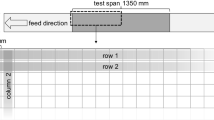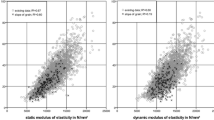Abstract
This paper aims to sketch the research results on machine grain angle determination on six indigenous hardwoods and spruce as reference. The system widely used for softwood grain angle determination (tracheid effect) is only restrictedly suitable for hardwoods. Therefore, the systems microwave scanning and electrical field strength measurement were tested as well as the above-mentioned tracheid effect with optimized settings. The measured grain angles were compared to visually determined splitting angles (reference angles). All three machine systems give reliable grain angle values for spruce. For oak, the tracheid effect is not applicable. The reference angle splitting contains weaknesses. Nonetheless, high coefficients of determination (R2) indicate a functioning automatic measurement system. Thus, it can be concluded that for the majority of the tested species automatic grain angle determination is possible. Ash does not show satisfactory results.

(adapted from Kollmann and Côté Jr 1968)










Similar content being viewed by others
References
Augustin M (2004) Eine zusammenfassende Darstellung der Festigkeitssortierung von Schnittholz [A summary of the strength grading of sawn wood]. Diploma thesis, Graz University of Technology, Austria
Baradit E, Aedo R, Correa J (2006) Knots detection in wood using microwaves. Wood Sci Technol 40:118–123
Becker G (1993) Verfahren der zerstörungsfreien Holzprüfung—Entwicklungstendenzen in Nordamerika and Folgerungen für die Anwendung in Mitteleuropa [Methods of non-destructive wood testing—development tendencies in North America and conclusions for application in Central Europe]. Holz Roh- Werkst 51:83–87
Bogosanovic M, Al Anbuky A, Emms GW (2010) Overview and comparison of microwave noncontact wood measurement techniques. J Wood Sci 56:357–365
Brännström M, Manninen J, Oja J (2008) Predicting the strength of sawn wood by tracheid laser scattering. BioResources 3:437–451
Bucur V (2003) Nondestructive characterization and imaging of wood. Springer Series in Wood Science, Berlin
Chazelas J, Vergne A, Bucur V (1988) Analyse de la variation des propriétes physique et méchanique locales du bois autour des noeuds [Analysis of the variation of the local physical and mechanical properties of wood around knots]. In: Actes du Colloque Comportement Mecanique du Bois, Bordeaux, pp 376–386
Daval V, Pot G, Belkacemi M et al (2015) Automatic measurement of wood fiber orientation and knot detection using an optical system based on heating conduction. Opt Express 23:33529–33539
Denzler JK, Weidenhiller A (2015) Microwave scanning as an additional grading principle for sawn timber. Eur J Wood Prod 73:423–431
Denzler JK, Koppensteiner J, Arthaber H (2013) Grain angle detection on local scale using microwave transmission. Int Wood Prod J 4:68–74
Denzler JK, Lux C, Arthaber H (2014) Contactless moisture content and density evaluation of sawn timber using microwave transmission. Int Wood Prod J 5:200–206
DIN 4074-5 (2008) Strength grading of wood—Part 5: Sawn hardwood. German Institute for Standardization, Berlin
Federal Ministry of Food and Agriculture (2014) Der Wald in Deutschland—Ausgewählte Ergebnisse der dritten Bundeswaldinventur [The forest in Germany—Selected results of the Third National Forest Inventory]. Bundesministerium für Ernährung und Landwirtschaft (BMEL)
Hu C, Tanaka C, Ohtani T (2004a) On-line determination of the grain angle using ellipse analysis of the laser light scattering pattern image. J Wood Sci 50:321–326
Hu C, Tanaka C, Ohtani T (2004b) Locating and identifying sound knots and dead knots on sugi by the rule-based color vision system. J Wood Sci 50:115–122
Kollmann F, Côté WA Jr (1968) Principles of wood science and technology, I. solid wood. Springer, Berlin
Kröner K, Pungs L (1952) Zur dielektrischen Anisotropie des Naturholzes im großen Frequenzbereich [About the dielectric anisotropy of natural wood in the high frequency range]. Holzforsch-Int J Biol Chem Phys Technol Wood 6:13–16
Makovíny I (1988) The anisotropy of wood dielectric constants as a function of anatomical structure. Holztechnologie 29:210–213
Mathews PC, Beech BH (1976) Method and apparatus for detecting timber defects. U.S. Patent 3976384 A, U.S. Patent Office, Washington, D.C.
McDonald K, Bendtsen BA (1986) Localized slope-of-grain—its importance and measurement. In: Pellerin RF (ed) Proceedings of the 5th nondestructive testing of wood symposium. Washington State University, Pullman, WA, pp 477–489
McDonald K, Cramer S, Bendtsen B (1988) Research progress in modeling tensile strength of lumber from localized slope of grain. In: Proceedings of the 6th Nondestructive testing of wood symposium. Washington State University, Pullman, WA, pp 113–123
Norimoto M, Yamada T (1972) The dielectric properties of wood VI: on the dielectric properties of the chemical constituents of wood and the dielectric anisotropy of wood. Wood Res 52:31–43
Norton JAP, Mclauchlan TA, Kusec DJ (1974) Wood slope-of-grain indicator. U.S. Patent 3805156, U.S. Patent Office, Washington, D.C.
Nyström J (2003) Automatic measurement of fiber orientation in softwoods by using the tracheid effect. Dev Image Process Scan Wood 41:91–99
Oliver-Villanueva JV (1993) Holzeigenschaften der Esche (Fraxinus excelsior L.) und ihre Variabilität im Hinblick auf Alter und Standraum [Wood properties of ash (Fraxinus excelsior L.) and their variability depending on age and stand]. Dissertation, Georg-August-University of Göttingen, Germany
Olsson A, Oscarsson J (2014) Three dimensional fibre orientation models for wood based on laser scanning utilizing the tracheid effect. In: Proceedings of the 2014 World Conference on Timber Engineering (WCTE), Quebec City, Canada
Olsson A, Oscarsson J, Serrano E et al (2013) Prediction of timber bending strength and in-member cross-sectional stiffness variation on the basis of local wood fibre orientation. Eur J Wood Prod 71:319–333
Petersson H (2010) Strength grading and prediction of shape stability by use of optical and laser-based scanning techniques. In: Proceedings of the 11th World Conference on Timber Engineering (WCTE) 2010, Trento, Italy
Sarén M-P, Serimaa R, Tolonen Y (2006) Determination of fiber orientation in Norway spruce using X-ray diffraction and laser scattering. Holz Roh Werkst 64:183–188
Schajer GS, Orhan FB (2005) Microwave non-destructive testing of wood and similar orthotropic materials. Subsurf Sens Technol Appl 6:293–313
Schajer GS, Orhan FB (2006) Measurement of wood grain angle, moisture content and density using microwaves. Holz Roh- Werkst 64:483–490
Schajer GS, Sutton DB (2016) Identification of 3D wood grain angle by directional reflection measurement. Wood Mater Sci Eng 11:170–175
Schickhofer G, Augustin M (2001) EU-Project INTELLIWOOD—final report; working package 3: strength correspondence. Graz, Austria
Schlotzhauer P, Emmerich L, Militz H, Bollmus S (2014) Machine grain angle determination on six European hardwoods. In: Németh R, Teischinger A, Schmitt U (eds) Proceedings of the “IAWS Plenary Meeting 2014—Sopron (Hungary)—Vienna (Austria) -Eco-efficient Resource Wood with special focus on hardwoods, University of West Hungary Press, Sopron, Hungary, pp 45–46
Seintsch B, Weimar H (2012) Actual situation and future perspectives for supply and demand of hardwood in Germany. In: Nemeth R, Teischinger A (eds) The 5th conference on hardwood research and utilisation in Europe 2012. University of West Hungary Press, Sopron, pp 301–312
Shen J, Zhou J, Vazquez O (2000) Experimental study of optical scattering and fiber orientation determination of softwood and hardwood with different surface finishes. Appl Spectrosc 54:1793–1804
Simonaho S-P, Palviainen J, Tolonen Y, Silvennoinen R (2004) Determination of wood grain direction from laser light scattering pattern. Opt Lasers Eng 41:95–103
Stahl DC, Cramer SM, McDonald KA (1990) Modeling the effect of out-of-plane fiber orientation in lumber specimens. Wood Fiber Sci 22:173–192
Steele PH, Neal SC, McDonald KA, Cramer SM (1991) The slope-of-grain indicator for defect detection in unplaned hardwood lumber. For Prod J 41:15–20
Torgovnikov GI (1993) Dielectric properties of wood and wood-based materials. Springer, Berlin
Viguier J, Jehl A, Collet R et al (2015) Improving strength grading of timber by grain angle measurement and mechanical modeling. Wood Mater Sci Eng 10:145–156
Acknowledgements
This work was supported by the German Federal Ministry of Food and Agriculture through the Agency for Renewable Resources (FNR). Very special thanks go to the Austrian Forest Products Research Society (Holzforschung Austria) for supplying a microwave scanning machine and the company ATB Blank GmbH for contributing the hardware and software to evaluate the ‘tracheid effect’ on hardwood. A hand-held device for the electrical field strength measurement was supplied by the company Metriguard Inc. (USA) and a second one by the DOKA Group Austria.
Author information
Authors and Affiliations
Corresponding author
Rights and permissions
About this article
Cite this article
Schlotzhauer, P., Wilhelms, F., Lux, C. et al. Comparison of three systems for automatic grain angle determination on European hardwood for construction use. Eur. J. Wood Prod. 76, 911–923 (2018). https://doi.org/10.1007/s00107-018-1286-z
Received:
Published:
Issue Date:
DOI: https://doi.org/10.1007/s00107-018-1286-z




